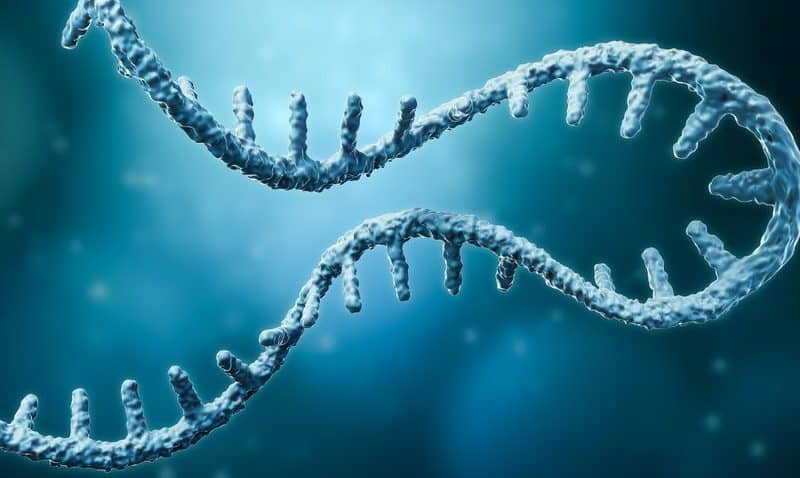Unlike the much-buzzed-about CRISPR-Cas9 gene-editing system, RNA editing doesn’t cause permanent changes to the genome, and could therefore have its own applications in treating genetic disorders. In search of better tools for altering RNA, two research teams from the U.S. and China recruited a naturally occurring protein inside the body to achieve efficient and safe editing.
A common RNA editing approach uses an enzyme called adenosine deaminase acting on RNA (ADAR) and engineered ADAR-recruiting guide RNAs to change the target RNA base. Existing methods deliver external ADAR variants, which poses problems in delivery, potential off-target editing and changes to normal cellular processes.
Research teams led by scientists at Peking University and the University of California, San Diego, both turned to circular ADAR-recruiting RNAs to attract native ADAR inside the body. The two methods enabled efficient RNA editing to treat a mouse model with the rare genetic disease of Hurler syndrome, the teams showed in new Nature Biotechnology studies published here and here.
Chinese gene-editing biotech EdiGene is developing the Peking University technology called LEAPER 2.0, with the study’s senior author Wensheng Wei as its scientific founder. Prashant Mali, senior author of the UCSD study, co-founded Seattle-based Shape Therapeutics to advance its RNA editing platforms.
Back in 2019, Wei and colleagues described LEAPER, which could recruit existing ADAR enzymes in the body without the need to introduce outside proteins.
This time, the team turned to circular ADAR-recruiting RNAs, dubbed circ-arRNAs. The new RNAs tend to be more stable and can remain active in the body longer than linear RNA because their circular structure helps them resist the cell’s RNA-degrading enzymes. Compared with linear RNA, circ-arRNAs showed editing efficiency that was up to threefold higher than their linear counterparts at multiple sites, with longer-lasting effects.
Circ-arRNA also showed improved editing specificity. For example, in a test of editing the PPIA gene, circ-arRNA showed 17 potential off-target edits, whereas a traditional method using external ADAR overexpression led to more than 16,000 rogue edits.
The researchers then further improved circ-arRNA by removing a nucleotide piece, and that almost eliminated the so-called bystander off-target editing. Doing so also retained relatively high editing efficiency at the target site.
Further tests showed circ-arRNA successfully activated the Wnt signaling pathway, whose dysregulation has been linked to cancer. It also corrected a mutation in the TP53 tumor suppressor gene.
In a mouse model of Hurler syndrome with mutation in the IDUA gene, treatment with an engineered circ-arRNA, delivered via an adeno-associated viral vector, significantly restored IDUA enzyme activity, leading to reduced liver buildup of the complex sugars that drive the rare disease.
The UCSD team took a similar approach. Researchers there noted that their previous ADAR-recruiting approach that used the body’s own ADAR was less efficient in RNA editing than seen with overexpression of external ADAR. Suspecting that the unstable nature of that tool had led to the low efficiency, the team engineered circular ADAR-recruiting guide RNAs, or cadRNAs.
The new guide RNAs are more effective partially because they are longer than traditional guide RNAs. “This basically makes them stickier for ADARs already present in the cell to come and bind to them,” Mali said in a statement.
The new tool showed highly robust RNA editing across multiple targets and cell lines, the team reported. The researchers also made additional improvements to reduce the bystander editing effect. But rather than deleting a nucleotide as the PKU team did, the UCSD scientists added loops around the target, along with other adjustments.
In their own study in Hurler syndrome mice, injection of cadRNAs corrected 7% to 17% of the mutant RNAs for the IDUA gene, leading to a 33% reduction in the accumulation of the complex sugars.
Based on the positive results, the PKU and UCSD teams said their circular RNA approaches, which don’t require co-delivery of any external proteins, have broad potential in RNA-editing therapies. To help move the technologies forward, EdiGene has raised a $67 million series B round in 2020, followed by a $62 million series B+ round in 2021, and Shape pulled off a $115 million financing round last year.

